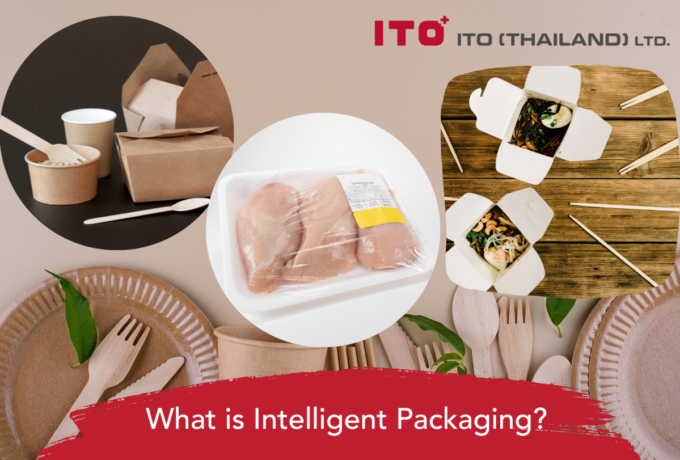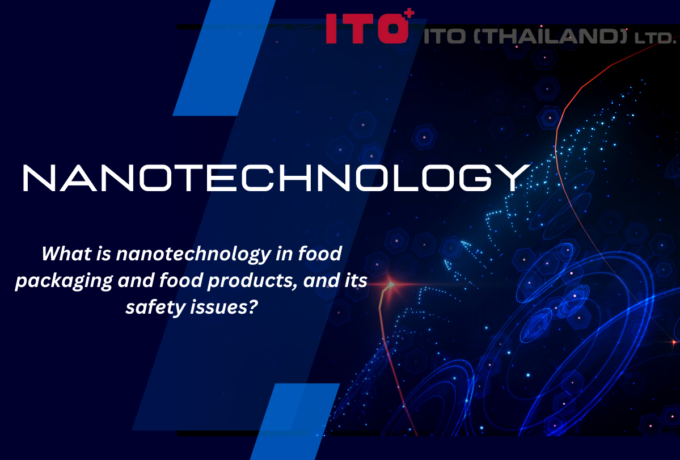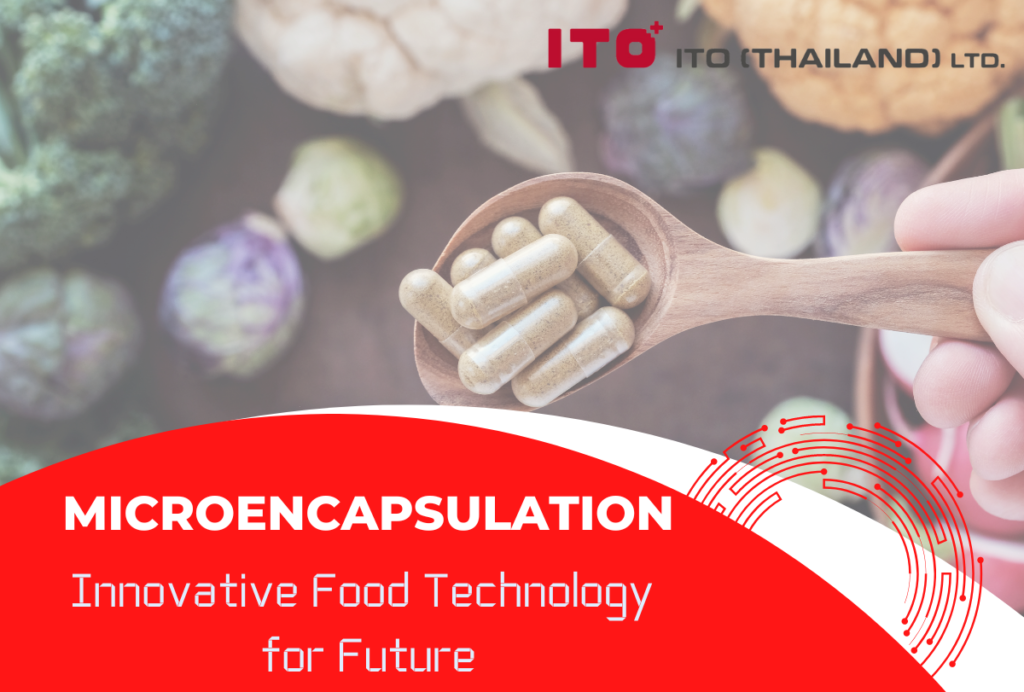ITO Thailand Hygiene Blog
Microencapsulation
In recent years, food scientists are developing a new and innovative tool to provide more beneficial properties to foods. For instance, functional foods can promote good health as well as reducing risks of diseases or improving immunity with this particular tool called microencapsulation technology. It is used to provide stability, protect, and retain the sensitive functionalities of food such as nutrients, beneficial bacteria and inhibit unpreferred interactions. Moreover, bioactive compounds (BACs) such as postbiotics can be delivered with an encapsulation as well. An introduction to microencapsulation, its processing, advantages, challenges, and its global food market situation will be discussed in this blog.
Processing of Microencapsulation
Encapsulation is commonly used in food processing to protect compound material against processing and storage condition, and microencapsulation is associated with an encapsulation diameter size from 3 to 800 micrometre (micron), while nanoencapsulation is associated with a particle size from 10 to 1,000 nanometre (1 micron) (Ye & Chi, 2018). There are two main components in encapsulation, the encapsulated compound is called the core and the encapsulating material is called the encapsulant (Choudhury et al., 2021). In other words, the encapsulant entraps the core (usually bioactive compounds) (Liu et al., 2021). Several techniques are compatible with microencapsulation, depending on the encapsulant but the most recognised techniques are dripping, spray drying, spray cooling, coacervation, fluidised bed coating, extrusion, and emulsification (Choudhury et al., 2021).
Advantages and Challenges
Consumer convenience should always be a key factor in developing new food products. An urban lifestyle has changed the way people consume their meals, and demand for products like gel sachets, drink powders, and liquid shots is rising (Gray, 2021). Moreover, the use of encapsulation is not only limited to food products, but in food packaging as well such as edible films and coatings, with several beneficial functions such as shelf-life extension, nutrition enhancement, oxidation prevention, anti-bacterial effects (Chaudhary et al., 2021). The active encapsulant could either perform as a releasing or absorbing system. Some examples of a releasing system are antioxidant, antibacterial, or CO2 emitters, on the other hand, absorbing system could be ethylene scavengers (to reduce the fruit ripening enzyme), O2 scavengers (to prevent the growth of aerobic bacteria), or moisture absorbents (Almasi et al., 2020). As previously mentioned, the addition of nutrients (E.g., vitamins and minerals) is necessary for populations with special dietary requirements such as older adults, athletics, or pregnant women.
However, challenges of this technology still exist. An acceptable material for microencapsulating is currently very limited because most water repellent microencapsulated materials are not soft and are easily detected by consumers, resulting in a worse sensory assessment quality (INNOV’IA, 2022). Furthermore, encapsulation requires the expertise of certain companies, and are still in its early development process which require a further study, especially in the food safety aspect as any compromises are unacceptable, for example, an encapsulation to control microbiological safety. Finally, the stability of microencapsulation in a varying atmosphere with different temperature or pressure, is uncertain as numerous microcapsules features are needed to be appropriately optimised such as their stability, permeability, as well as releasing and absorbing mechanisms (MarketsandMarkets, 2020).
Microencapsulation in the Global Food Market
Microencapsulation has been extensively used in the pharmaceutical and healthcare sectors, especially the ability to absorb undesirable bitter taste or smell in drugs, and the ability to enhance drug delivery stability (MarketsandMarkets, 2020). The COVID-19 pandemic has boosted the demand of vitamins and supplements to improve immunity, which the ease of restrictions also supported the supply and ameliorated consumer accessibility.
Functional foods consumption trends are increasing as more consumers have developed an awareness for a healthy eating habit during the pandemic, and it is related with the use of microencapsulation. Major food company like Nestlé has launched functional foods through their product line up such as Bear Brand milk, Cerevita cereal, and Maggi sauce, while Givaudan (a Swiss manufacturer of flavours) has launched a fat encapsulation technology called PrimeLock+, for meat alternatives with 30% lower calories and 75% of fat contents (The Business Research Company, 2022). In probiotic drinks, encapsulation with microgel is frequently used to prevent probiotics from deterioration in acidic condition of the stomach and delivered at target area, the gut (Lim, 2021).
Undoubtedly, it is proven that microencapsulation is a reliable and innovative food technology, and the benefits seem to outweigh the drawbacks. Microencapsulation, with functional foods, and probiotics products are offering a great value of benefits to consumers. It is believed that a wider range of foods will be able to be encapsulated with development of new encapsulant materials, and consumers can expect even more health benefits. ITO Thailand acknowledges the success in development of encapsulation technology concurrently with the delivery of safe food for consumers by comprehensive food hygiene management products and services.
References
Almasi, H., Jahanbakhsh Oskouie, M., & Saleh, A. (2020, June 26). A review on techniques utilized for design of controlled release food active packaging. Critical Reviews in Food Science and Nutrition, 61(15), 2601–2621. https://doi.org/10.1080/10408398.2020.1783199
Chaudhary, V., Thakur, N., Kajla, P., Thakur, S., & Punia, S. (2021). Application of Encapsulation Technology in Edible Films: Carrier of Bioactive Compounds. Frontiers in Sustainable Food Systems, 5. https://doi.org/10.3389/fsufs.2021.73
Choudhury, N., Meghwal, M., & Das, K. (2021, June 18). Microencapsulation: An overview on concepts, methods, properties and applications in foods. Food Frontiers, 2(4), 426–442. https://doi.org/10.1002/fft2.94
Gray, N. (2021). Beyond supplements: How are new encapsulation technologies driving innovation – WATCH. NutraIngredients. Retrieved September 26, 2022, from https://www.nutraingredients.com/Article/2019/03/22/Beyond-supplements-How-are-new-encapsulation-technologies-driving-innovation-WATCH
INNOV’IA. (2022). Microencapsulation as an innovative tool to enhance the functions and properties of bioactive ingredients. Retrieved September 26, 2022, from https://www.innov-ia.com/microencapsulation-as-an-innovative-tool-to-enhance-the-functions-and-properties-of-bioactive-ingredients/
Lim, G. Y. (2021). Survive the journey: PERKii sees steady sales of probiotic drinks made with exclusive encapsulation technology. NutraIngredients-Asia. Retrieved September 27, 2022, from https://www.nutraingredients-asia.com/Article/2021/09/01/Survive-the-journey-PERKii-sees-steady-sales-of-probiotic-drinks-made-with-exclusive-encapsulation-technology
Liu, B., Jiao, L., Chai, J., Bao, C., Jiang, P., & Li, Y. (2021). Encapsulation and Targeted Release. Food Hydrocolloids, 369–407. https://doi.org/10.1007/978-981-16-0320-4_11
MarketsandMarkets. (2020). Microencapsulation Market. Retrieved September 26, 2022, from https://www.marketsandmarkets.com/Market-Reports/microencapsulation-market-83597438.html
The Business Research Company. (2022). Food Encapsulation Global Market Report 2022. ReportLinker. Retrieved September 27, 2022, from https://www.reportlinker.com/p06282672/Food-Encapsulation-Global-Market-Report.html?utm_source=GNW
Ye, C., & Chi, H. (2018, February). A review of recent progress in drug and protein encapsulation: Approaches, applications and challenges. Materials Science and Engineering: C, 83, 233–246. https://doi.org/10.1016/j.msec.2017.10.003
Related Post
-

Biodegradable Packaging
As straightforward as its name, it means any packaging that will naturally fall apart and decompose. In recent years, biodegradable packaging has been included as one of the sustainable development goals for several organisations. A similar issue, bioplastics, an alternative to sustainable living, was discussed in a previous blog. However, there are some differences between them. For example, bioplastics are made from raw materials sourced from renewable and natural sources and could or could not be biodegradable. In contrast, biodegradable plastic can naturally degrade through living organisms no matter the source material it originates from. The development history of biodegradable packaging, frequently used materials, the pros and cons of biodegradable packaging, and its future trends will be discussed in this blog.
-

Precision Agriculture
Precision agriculture has revolutionised how we approach crop management by optimising the inputs to meet specific requirements. Even though it is not a new system, recent technologies have made it possible to apply it in practical productions. In this blog, we will discuss the definition of precision agriculture, its pros and cons, and future trends.
-

Vertical Farming
Agriculture has utilised nearly all the available land, causing growing difficulty in finding land on the earth’s surface. With limited resources, meeting the world’s food demands will require more innovative and dependable methods of producing safe food, and the answer lies in vertical farming.
-

Intelligent Packaging
Without packaging, food products would last for only a short period of time, impossible for logistics management, difficulties in the supply chain system, quick quality deterioration, and prone to contamination to risky foodborne pathogens. In reality, there are many more functions that packaging is contributing to food products, as well as many types of smart packaging. Intelligent packaging is considered to be a part of smart packaging, so in this blog, we will discuss the contribution of intelligent packaging to food products.
-

Robots & automation in the food industry
Entering a new era in the food industry with robotics and automation in the food industry
-

Nanotechnology in the Food Industry
Nanotechnology has been brought to our attention for the last decades, and it has provided various beneficial applications to the food industry. Unlike other technology, nanotechnology has broadened the knowledge in the food industry to another level in a nanoscale dimension. It involves almost every aspect of the food industry, including food packaging, food processing, as well as functional food development and enhancement of food safety. In this blog, we will discuss how nanotechnology is used in food packaging and food products, and the most important part, its safety issues.










